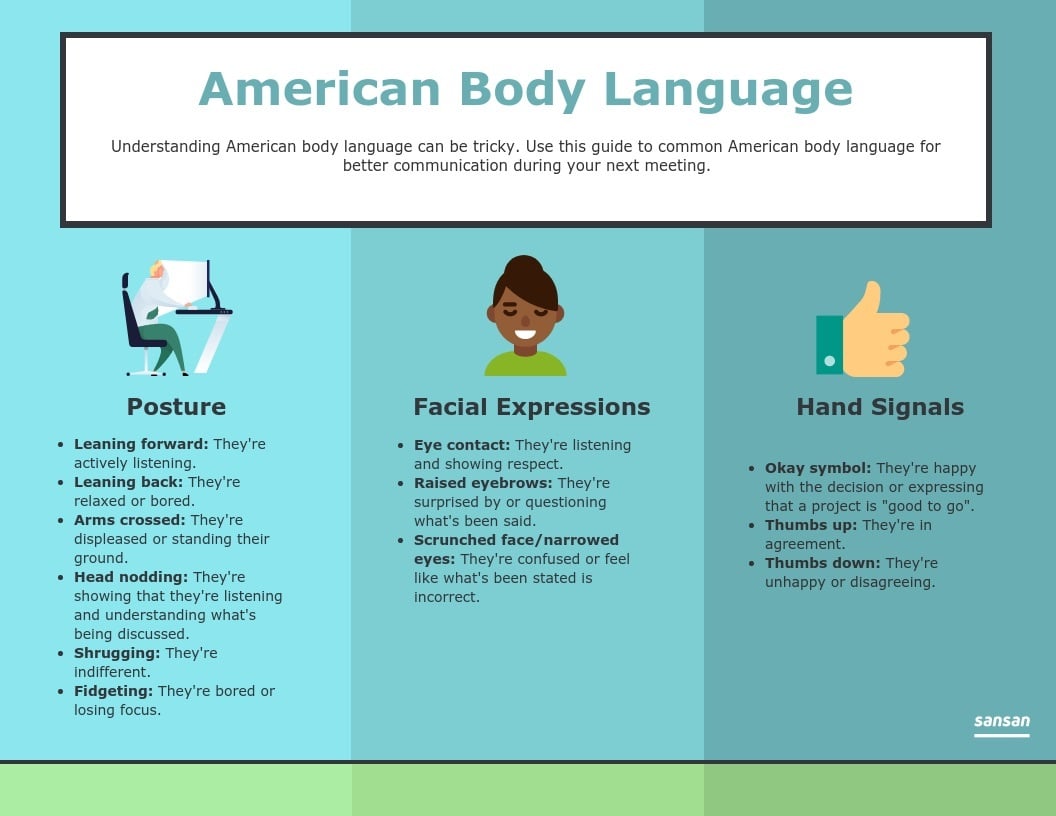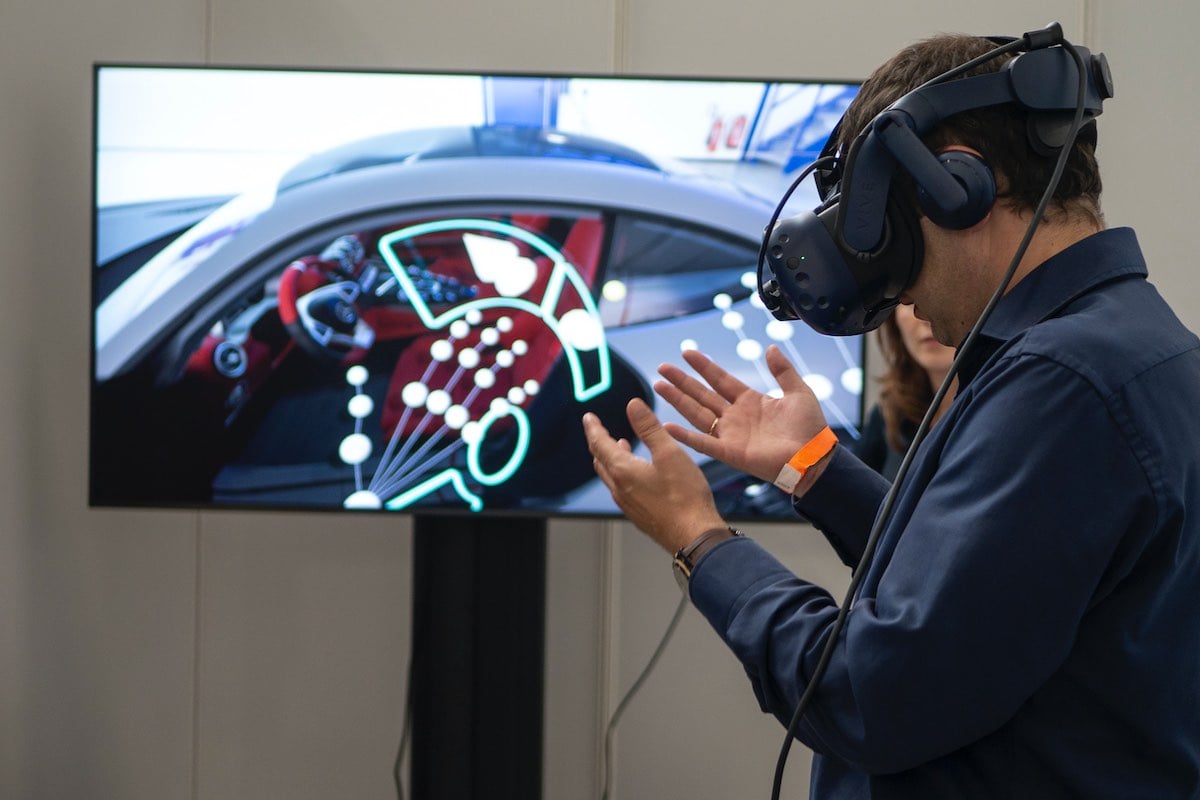In a recent U.S. survey, 91% of respondents said they used their mobile device "all the time." This is in addition to their PCs. American businesspeople are nearly always online and video calls have become essential ways of doing business amid the current climate. In other words, if you work globally, you'll probably be video-chatting with some Americans.
Americans are multicultural, but quite consistent in their communication. Compared especially with Asian cultures, Americans can be more physical and expressive. The face moves, the hands move, the body moves. Understand this movement, know how to use it yourself, and you'll do better business with your U.S. counterparts.
If you’ve interacted with colleagues or clients abroad before, you know that cultural differences are important to acknowledge, especially when a major deal or project is on the line. Prepare for your next video meeting with your U.S.-based colleagues or clients by using this guide to reading American body language.
American business etiquette
The U.S. is the world's biggest economy and you've likely grown up with Hollywood movies and U.S. TV shows wherever you are. This didn't mean you had to interact and do business with Americans, though. If you find yourself on a remote team or working a deal, it may still seem foreign.
In general, U.S. business etiquette is:
- Less formal in nature: American etiquette is less formal than many other countries that are more traditional. From greetings to their way of speech, Americans generally have a much more open and familiar way of interacting.
- Forward communication: In the U.S., being straightforward, and even candid, is seen as a good attribute. Americans are known for their friendly yet forward demeanor in both personal and business dealings. This is different from perhaps more subtle and slower-developing styles of Asian communication.
- Opportunity-oriented: American businesspeople typically prioritize opportunity over relationships. That’s not to say they don’t value business relationships, but they do believe in sealing the deal when the opportunity strikes, even if they’re not particularly familiar with the company, agents, etc. they’re working with.
- Fast-paced: Americans like to get to the point when it comes to collaborating on projects or making deals. Typically, they’ll want to get straight to business when they pick up your call—due to their friendly nature, they'll probably engage in a minute or two of small talk, but getting to know you isn’t the purpose of the call for them. This shouldn’t be interpreted as rude; they’re “on the clock” and are simply using that time as is expected of them.

All of this will come in handy during your video chats and allow you to better interpret their body language.
Key aspects of American body language in business
Let’s dive into how U.S. business etiquette translates into body language:
- Eye contact: In American culture, eye contact is important when talking to someone. It signifies that you're paying attention and showing them respect as a speaker. That doesn’t mean to make constant eye contact, which can be rude or even scary. Instead keep eye contact during important parts of the discussion, and look at key people when you're speaking.
- Head nodding: You'll notice that Americans often nod their head while listening or when you emphasize a point. This is a signal that they're paying attention to what you're saying and want to communicate their understanding. It doesn't always mean they agree; rather, it shows they're engaged. Simply staring at someone with no movement and no change of expression can be seen as a bit threatening, or even weird. Smiling helps, too.
- Leaning forward or back: As part of their more laid back demeanor, Americans tend to lean during meetings and video conferences. If they're leaning forward, it's often a sign that they're engaged and actively listening to what you’re discussing. If they're leaning back, it may be a sign that they're comfortable with you or in a more relaxed state at this point in the conversation. It may also mean disinterest, especially if their eyes wander somewhere else. Pay attention and try to re-engage someone who's "drifting away."
- Arms crossed: In some cases, crossing arms can mean that someone is defensive or sensitive about the topic of conversation. This may be seen when making negotiations to show that they are standing their ground or when collaborating on a project if someone is protective over their work. But don't make too much of it. For some people, especially men, it's just more comfortable and it's their thinking pose.
- OK symbol: The OK symbol is nearly universal, but in some cultures it can mean different things (e.g., in Japan, conventionally, it means "money") gestured by touching the pointer finger and thumb together to create an “O” shape, while the other three fingers are pointing upwards. The OK symbol is used as a way to confirm that someone is comfortable with a suggestion or agrees with whatever was suggested. It can also mean that things are “good to go”, when asked about the status of something. It's pretty much the same as a thumbs up.
- Thumbs up/thumbs down: A thumbs up (where the thumb is sticking up with the other four fingers curled into their fist), is typically used to show agreement or enthusiasm. On the other hand, a thumbs down (where the hand and thumb is facing downwards) is used to signal dislike or disagreement.
- Shrugging: A shrug (casually raising their shoulders up and down) could mean that they feel indifferent about the topic in question. This may be their way of telling you “you decide”, or that they don’t have a strong opinion on the matter. A shrug with open palms may be an even stronger expression of indifference, or even confusion.
- Fidgeting: This could mean you’re losing their interest. It usually isn’t intentional, but it is a sign that their attention is wandering. If you notice them fidgeting, it may be a good idea to do your best to ask them a question to re-engage them or wrap up the point you’re trying to make.
- Raised eyebrows: Americans tend to be very expressive with their faces, and one of the most widely used facial expressions is raised eyebrows. This can be used to communicate doubt (or questioning), shock or surprise, or simply an acknowledgement like "oh, you're talking to me?".
- Scrunched face/narrowed eyes: To express confusion, Americans will often scrunch their forehead and narrow their eyes. If you see this facial expression, check in with them to ensure you’re both on the same track.
In addition to these common American body language queues, learn what's OK and not OK to discuss.
Using Sansan to manage your global business
One of the biggest challenges in the business world is networking—from keeping track of contact information to remembering who’s who. Sansan's complete customer profiles start with the full information you get on a business card. That's accurate, first-party data.
Now this includes Virtual Cards (online business cards), which you can exchange with the other person during your Zoom, Skype, or any other video-conferencing. Your U.S. counterpart doesn't have to be a Sansan user to swap cards either. Learn more here.
Americans, as mentioned, like a bit of small talk, and swapping cards online can really get the ball rolling.
With your newfound knowledge of American body language and a leading tool to help you manage your professional connections, you can go into your next global video conference with confidence.
Guest Author

Alexis Maness is a contributing editor for 365businesstips.com. As a professional content writer, she has over five years of experience and is a contributing writer for several San Diego magazines. Alexis specializes in topics related to business, marketing, finance, and hospitality and tourism.




